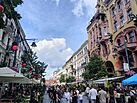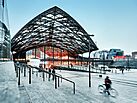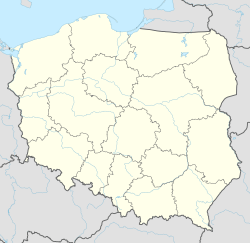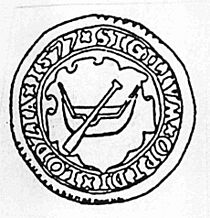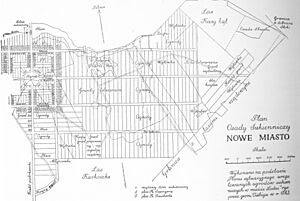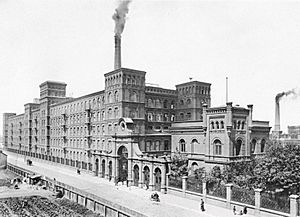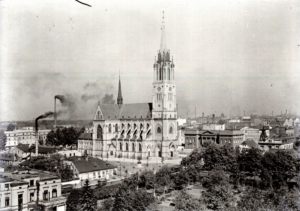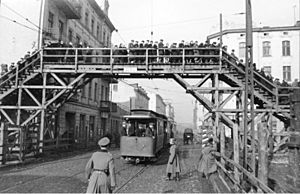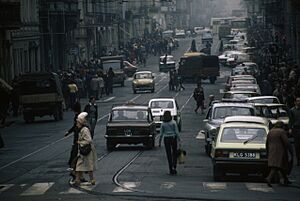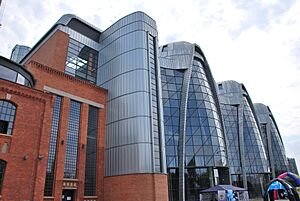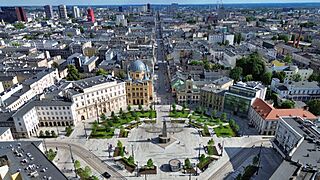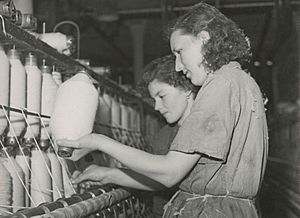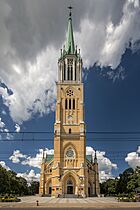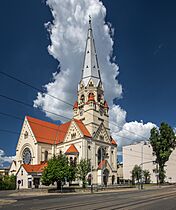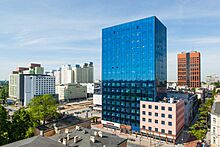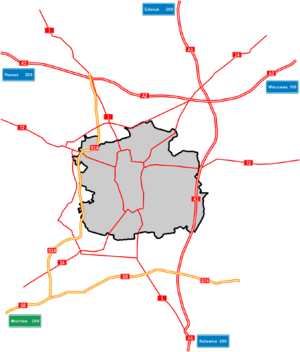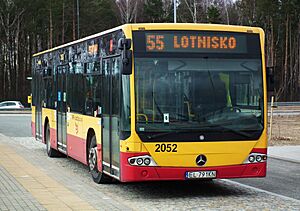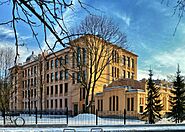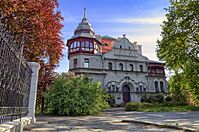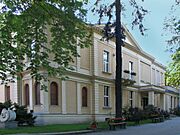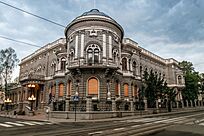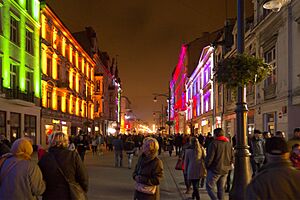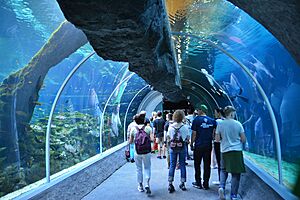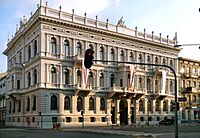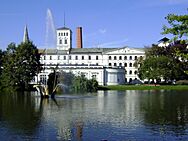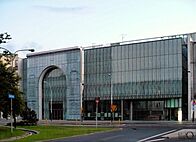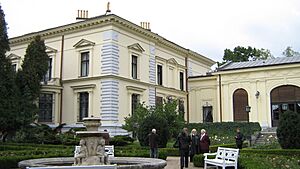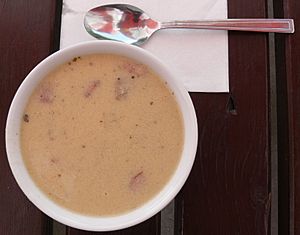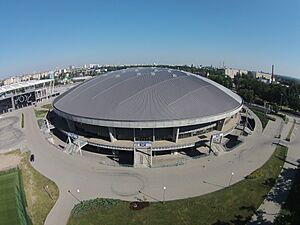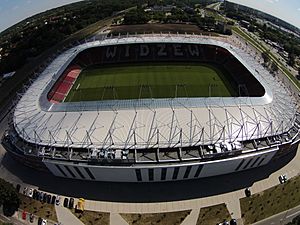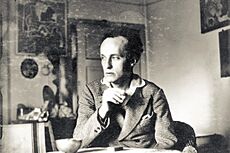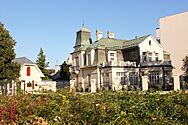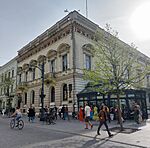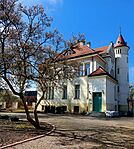Łódź facts for kids
Quick facts for kids
Łódź
|
|||||
|---|---|---|---|---|---|
|
Piotrkowska Street
Łódź Fabryczna railway station
Poznański Palace, Museum of Łódź
Church of the Descent of the Holy Spirit
Księży Młyn
White Factory
Manufaktura
|
|||||
|
|||||
| Motto(s):
Ex navicula navis ("From a boat a ship")
|
|||||
| Country | |||||
| Voivodeship | |||||
| County | city county | ||||
| First mentioned | 1332 | ||||
| City rights | 1423 | ||||
| City Hall | Juliusz Heinzl Palace | ||||
| Government | |||||
| • Body | Łódź City Council | ||||
| Area | |||||
| • City | 293.25 km2 (113.22 sq mi) | ||||
| • Metro | 2,496 km2 (964 sq mi) | ||||
| Highest elevation | 278 m (912 ft) | ||||
| Lowest elevation | 162 m (531 ft) | ||||
| Population
(30 June 2023)
|
|||||
| • City | 655,279 |
||||
| • Density | 2,245/km2 (5,810/sq mi) | ||||
| • Metro | 1,100,000 | ||||
| • Metro density | 441/km2 (1,140/sq mi) | ||||
| GDP | |||||
| • Metro | €16.839 billion (2020) | ||||
| Time zone | UTC+1 (CET) | ||||
| • Summer (DST) | UTC+2 (CEST) | ||||
| Postal code |
90-001 to 94–413
|
||||
| Area code(s) | +48 42 | ||||
| Vehicle registration | EL | ||||
| Primary airport | Łódź Władysław Reymont Airport | ||||
| Highways | |||||
Łódź is a big city in central Poland. It used to be a major industrial hub, especially for textiles. Today, it is the capital of the Łódź Voivodeship region. The city is about 120 kilometers (75 miles) southwest of Warsaw, Poland's capital. As of 2023, Łódź has a population of over 655,000 people, making it the fourth largest city in Poland.
Łódź was first mentioned in records in the 1300s. It officially became a town in 1423. For many centuries, it was a small, quiet place. In the 1800s, during the Second Industrial Revolution, Łódź grew very quickly. Many factories, especially textile factories, were built. People from different countries, like Germans and Jews, moved to Łódź for work. This made the city very diverse. However, this fast growth also led to big differences between the rich factory owners and the poor workers. You can read about this in the famous novel The Promised Land.
During World War II, Łódź was taken over by Germany. Its name was changed to Litzmannstadt for a short time. The city's large Jewish population was forced into a special area called the Łódź Ghetto. From there, they were sent to terrible camps. After the war, in 1945, Łódź became Poland's temporary capital while Warsaw was being rebuilt.
After 1989, when Poland changed its government and economy, Łódź faced some tough times. Many factories closed, and the city's population decreased. But in the 2010s, Łódź started to come back to life. Many old buildings and areas in the city center are being restored. Łódź is now known for its famous National Film School, where many well-known Polish actors and directors, like Andrzej Wajda and Roman Polanski, studied. In 2017, UNESCO named Łódź a "City of Film" because of its creative spirit.
Contents
Exploring Łódź: A City of History and Growth
How Łódź Got Its Name
The name of the city, Łódź, means 'boat' in English. No one is completely sure how the city got its name. Some people think it comes from an old village called Łodzia or from the small River Łódka, where the city was built. Others believe it might be linked to the word łoza, which means 'willow tree', or an old Polish name, Włodzisław.
Łódź Through the Ages
Łódź was first mentioned in 1332. It was a small village given to a group of bishops. In 1423, the Polish King Władysław II Jagiełło officially made it a town. For hundreds of years, Łódź was a small farming town surrounded by forests and wetlands. Its first official symbols, like a boat with an oar, appeared on seals in the 1500s.
In 1793, Łódź became part of Prussia. Later, it was part of the Napoleonic Duchy of Warsaw. After 1815, it joined Congress Poland, which was connected to the Russian Empire.
The Industrial Revolution in Łódź
Around 1820, the government decided to make Łódź an industrial city. They planned new streets and areas for factories and homes. Piotrkowska Street became the main road. Many German craftsmen moved to Łódź to work in the new textile industry. They were even given special tax breaks to encourage them to settle there.
In 1851, a trade barrier with Russia was removed. This allowed Łódź to sell its textiles freely to Russia, where there was a huge demand. This helped the city's industry grow even faster. The first steam-powered loom in Poland started working in Łódź in 1839. Railways were also built, connecting Łódź to bigger markets.
Rich factory owners, like Karl Wilhelm Scheibler and Izrael Poznański, built many important buildings in Łódź. They also helped fund schools, hospitals, and churches. Poznański built a massive textile factory complex, which included factories, power plants, and even homes for workers. Scheibler's Księży Młyn became one of Europe's largest industrial areas.
The late 1800s were a time of huge growth but also big social problems. Working conditions were often very tough. This led to a strong workers' movement in Łódź. In 1892, there was a big workers' protest that was stopped by the military.
By the early 1900s, Łódź was a very modern city. The first cinema in Poland opened here in 1899. In 1905, there was another large strike by unemployed workers. The beautiful Łódź Cathedral was finished in 1912. By 1914, Łódź was one of the most crowded industrial cities in the world. After World War I, when Poland became independent again, the textile industry in Łódź slowed down.
Łódź in Independent Poland (1918–1939)
After Poland regained its independence in 1918, Łódź became the capital of the Łódź Voivodeship region in 1919. The years after the war were difficult for the city's economy. The Great Depression also hurt the textile industry.
Because of its fast growth, Łódź didn't have good infrastructure. Pollution was a big problem, and sanitation was poor. The city started building a proper sewage system in the 1920s. However, many new cultural and educational places were also created, like schools, museums, and libraries. The city's first airport opened in 1925, and a radio station started broadcasting in 1930.
Łódź During World War II (1939–1945)
In September 1939, Germany invaded Poland, and Łódź was taken over. The city was renamed Litzmannstadt. The German authorities forced many people to work for low wages. Polish intellectuals were arrested and sent to camps or killed. Polish children were also taken from their families.
The Germans created the Łódź Ghetto in the city. Over 200,000 Jewish people from the region were forced to live there. From the ghetto, they were sent to terrible German camps. The Łódź Ghetto was the second largest in Europe and the last one to be closed, in August 1944. Very few Jewish people from Łódź survived these events.
After World War II (1945–1989)
After Łódź was freed by Soviet forces in January 1945, it became Poland's unofficial temporary capital. This was because Warsaw was heavily damaged and needed to be rebuilt. Many people from other parts of Poland moved to Łódź.
In 1945, the University of Łódź was opened. In 1948, the famous National Film School started, becoming a leading school for film and drama in Poland. After the war, new housing areas were built on the outskirts of the city. This caused the old city center to become less important and fall into disrepair.
Łódź Today (1990–Present)
After 1989, the textile industry in Łódź collapsed, leading to economic challenges. However, the city's beautiful old buildings and industrial heritage started to attract tourists. In the 2000s, Piotrkowska Street, the main street, was renovated with new shops and restaurants. Łódź now hosts many festivals each year.
The city government is working hard to transform Łódź from an old industrial city into a lively modern place. They even tried to host the 2022 International EXPO, an event about urban renewal, but another city was chosen.
What Łódź Looks Like
Łódź covers about 293 square kilometers (113 square miles) and is located in the middle of Poland. The city is on a flat plain, with no mountains. The highest points are less than 50 meters (164 feet) above the surrounding land. The soil is mostly sandy. Łódź has fewer forests compared to other parts of Poland.
Łódź Weather
Łódź has a humid continental climate, meaning it has warm summers and cold winters. The lowest temperature ever recorded was in January 1987.
| Climate data for Łódź, elevation: 68 m (223 ft), 1991–2020 normals, extremes 1951–present | |||||||||||||
|---|---|---|---|---|---|---|---|---|---|---|---|---|---|
| Month | Jan | Feb | Mar | Apr | May | Jun | Jul | Aug | Sep | Oct | Nov | Dec | Year |
| Record high °C (°F) | 12.8 (55.0) |
17.5 (63.5) |
23.8 (74.8) |
29.9 (85.8) |
32.7 (90.9) |
36.3 (97.3) |
37.3 (99.1) |
37.6 (99.7) |
34.7 (94.5) |
25.9 (78.6) |
19.2 (66.6) |
14.9 (58.8) |
37.6 (99.7) |
| Mean daily maximum °C (°F) | 1.2 (34.2) |
2.9 (37.2) |
7.4 (45.3) |
14.4 (57.9) |
19.4 (66.9) |
22.7 (72.9) |
24.9 (76.8) |
24.6 (76.3) |
19.1 (66.4) |
13.0 (55.4) |
6.8 (44.2) |
2.4 (36.3) |
13.2 (55.8) |
| Daily mean °C (°F) | −1.5 (29.3) |
−0.3 (31.5) |
3.1 (37.6) |
9.0 (48.2) |
13.8 (56.8) |
17.1 (62.8) |
19.2 (66.6) |
18.7 (65.7) |
13.7 (56.7) |
8.6 (47.5) |
3.9 (39.0) |
0.0 (32.0) |
8.8 (47.8) |
| Mean daily minimum °C (°F) | −4.0 (24.8) |
−3.3 (26.1) |
−0.7 (30.7) |
3.6 (38.5) |
8.2 (46.8) |
11.6 (52.9) |
13.6 (56.5) |
13.3 (55.9) |
9.0 (48.2) |
5.0 (41.0) |
1.3 (34.3) |
−2.4 (27.7) |
4.6 (40.3) |
| Record low °C (°F) | −31.1 (−24.0) |
−27.4 (−17.3) |
−21.9 (−7.4) |
−8.0 (17.6) |
−3.6 (25.5) |
−0.3 (31.5) |
4.2 (39.6) |
3.3 (37.9) |
−1.9 (28.6) |
−9.9 (14.2) |
−16.8 (1.8) |
−24.6 (−12.3) |
−31.1 (−24.0) |
| Average precipitation mm (inches) | 35.3 (1.39) |
34.1 (1.34) |
37.6 (1.48) |
35.2 (1.39) |
60.9 (2.40) |
62.3 (2.45) |
81.1 (3.19) |
54.1 (2.13) |
53.4 (2.10) |
44.0 (1.73) |
39.4 (1.55) |
40.7 (1.60) |
578.1 (22.76) |
| Average extreme snow depth cm (inches) | 6.8 (2.7) |
6.6 (2.6) |
4.7 (1.9) |
1.6 (0.6) |
0.0 (0.0) |
0.0 (0.0) |
0.0 (0.0) |
0.0 (0.0) |
0.0 (0.0) |
0.2 (0.1) |
2.2 (0.9) |
3.6 (1.4) |
6.8 (2.7) |
| Average precipitation days (≥ 0.1 mm) | 17.27 | 14.60 | 14.17 | 11.17 | 13.33 | 13.43 | 13.77 | 11.80 | 11.73 | 13.03 | 14.30 | 16.37 | 164.97 |
| Average snowy days (≥ 0 cm) | 15.3 | 13.3 | 6.2 | 0.9 | 0.0 | 0.0 | 0.0 | 0.0 | 0.0 | 0.2 | 3.4 | 8.6 | 47.9 |
| Average relative humidity (%) | 87.6 | 84.2 | 77.5 | 68.6 | 70.0 | 70.5 | 71.3 | 71.4 | 78.9 | 84.1 | 89.2 | 89.4 | 78.6 |
| Mean monthly sunshine hours | 48.2 | 65.8 | 122.7 | 187.0 | 241.8 | 244.6 | 250.9 | 243.4 | 160.1 | 111.1 | 51.2 | 40.4 | 1,767.3 |
| Average ultraviolet index | 1 | 1 | 2 | 4 | 6 | 6 | 6 | 6 | 4 | 2 | 1 | 0 | 3 |
| Source 1: Institute of Meteorology and Water Management | |||||||||||||
| Source 2: Meteomodel.pl (records, relative humidity 1991–2020), WeatherAtlas (UV) | |||||||||||||
People and Culture in Łódź
Who Lives in Łódź?
As of 2020, Łódź had over 672,000 residents. The city's population density is about 2,292 people per square kilometer (5,940 per square mile). More than half of the residents are women. This is partly because the textile factories in the past attracted many female workers.
| Historical population | ||
|---|---|---|
| Year | Pop. | ±% |
| 1950 | 620,183 | — |
| 1960 | 709,698 | +14.4% |
| 1970 | 762,454 | +7.4% |
| 1978 | 823,326 | +8.0% |
| 1988 | 854,261 | +3.8% |
| 2002 | 789,318 | −7.6% |
| 2011 | 728,892 | −7.7% |
| 2021 | 670,642 | −8.0% |
The population of Łódź was highest in 1988, with about 854,000 people. Since then, it has decreased. This is due to fewer births, people moving away, and other factors. Łódź used to be Poland's second-largest city, but it is now the fourth largest. The city is working to attract new residents and businesses.
Historically, Łódź was a very diverse city. People from different parts of Europe lived there. In 1839, about 78% of the population was German. By 1913, nearly half the people were Poles, with many Jews and Germans also living in the city. Before World War II, the Jewish community in Łódź grew to over 200,000 people.
Faiths in Łódź
Most people in Łódź are Roman Catholic, which is the main religion in Poland. The main Catholic church is the Łódź Cathedral, a very tall and beautiful building. It was finished in 1912.
Łódź also had a large Protestant population, especially in the 1800s, due to German textile workers moving there. The Lutheran Church is the largest Protestant group. There are also other Christian churches and groups like Jehovah's Witnesses.
Before World War II, Judaism was the second largest religion in Łódź. There were many synagogues and Jewish cultural places. Sadly, almost all of them were destroyed during the war. Today, there is still a Jewish community in Łódź.
Economy and Getting Around Łódź
How Łódź Makes Money
Before 1990, Łódź was famous for its textile industry. It was even called the "Polish Manchester" because it produced so much fabric. The city grew very fast because of this industry. However, in the 1990s, the textile industry declined.
Today, Łódź is no longer a big industrial center. Instead, it has become a major hub for business services. Many companies choose Łódź because it has skilled workers and good universities.
Łódź is in a great central location in Poland. Two major highways, the A1 (north-south) and A2 (east-west), cross near the city. This makes it easy for businesses to transport goods. The railway connection to Warsaw has also been improved, making travel faster.
Many international companies have opened offices in Łódź. For example, Dell moved some of its production here. This has helped lower the unemployment rate in the city.
Getting Around Łódź
Łódź is very well connected. It's close to the center of Poland, where major highways meet. This connects Łódź to important routes across Europe and even to China via the "New Silk Road" cargo rail. The city has an international airport, highways, and a good railway system. There are also many bicycle routes.
Major roads include:
- A1: From Gdańsk in the north to Cieszyn in the south.
- A2: From the German border in the west to Warsaw in the east.
- S8: Connects Łódź to Wrocław and Warsaw.
- S14: A local expressway around Łódź.
Łódź Airport
The city has an international airport called Łódź Władysław Reymont Airport. It's about 6 kilometers (4 miles) from the city center. It has flights to various places in Europe.
Public Transportation
Łódź has a public transport company that runs many bus and tram routes. The tram network is one of the longest in Poland. It was the first electric tram system in this part of Poland, starting in 1898. Trams also connect Łódź to nearby towns like Pabianice and Konstantynów Łódzki.
Train Travel
Łódź has several train stations. The two main ones are Łódź Fabryczna and Łódź Kaliska. They were built at different times and didn't have a direct connection. However, a new tunnel is being built to connect them, which will make Łódź a major railway hub in Poland. This tunnel will also create a new rapid transit system for the city, sometimes called the "Łódź Metro."
In 2016, a new underground Łódź Fabryczna station opened. It's considered one of the most modern train stations in Poland. It also serves as a hub for intercity buses, taxis, and local trams. This new station is part of a big project to renew the city center.
Learning and Fun in Łódź
Top Universities in Łódź
Łódź is a great place for students. It has many universities and colleges. The biggest state-owned universities are:
- University of Łódź (UŁ)
- Lodz University of Technology (PŁ)
- Medical University of Łódź
- National Film School in Łódź
- Academy of Music in Łódź
- Academy of Fine Arts In Łódź
These universities offer many different courses. The National Film School is especially famous.
The National Film School in Łódź
The National Film School in Łódź is a very important school for people who want to become actors, directors, or work in TV and film. It opened in 1948. After World War II, Łódź was one of the few big Polish cities that wasn't destroyed. So, the film school helped Łódź become a major cultural center.
Many famous Polish filmmakers, like Roman Polanski and Andrzej Wajda, studied here. The school helped create the "Polish Film School" style of filmmaking in the 1950s.
Famous Places and Events
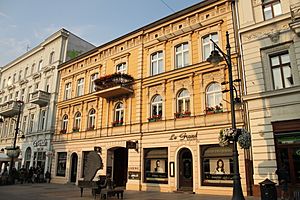
The most famous place in Łódź is Piotrkowska Street. It's the main street and a big tourist attraction. It's over 5 kilometers (3 miles) long, making it one of the longest commercial streets in the world. Many old buildings from the 1800s have been restored. You'll find most of the city's restaurants, bars, and cafes here. Important buildings on Piotrkowska Street include the Old Town Hall and several beautiful churches.
Many old factories and buildings in the city center have been renovated. A great example is the Manufaktura complex. This used to be a huge cotton factory owned by Izrael Poznański. Now, it's a modern shopping mall with restaurants, a hotel, a cinema, a museum, and a science center. It opened in 2006 and is a popular spot for both locals and tourists. Another old factory, Księży Młyn, has been turned into offices and homes.
Łódź also has many green spaces. Forests cover about 9.6% of the city, and parks make up another 2.3%. Las Łagiewnicki (Łagiewnicki Forest) is one of the largest city forests in Europe. It's a great place for hiking and has historical chapels. The city has 44 parks, with 11 of them having historical importance. The Józef Piłsudski Park is very large and is near the Łódź Zoo and botanical garden.
The Jewish Cemetery on Bracka Street is one of the biggest in Europe. It was established in 1892. During World War II, it was part of the Łódź Ghetto. Many people were buried there during that time. It has about 180,000 graves, including many old and beautiful monuments. The mausoleum of Izrael Poznański is one of the largest Jewish tombstones in the world.
Museums to Visit in Łódź
Łódź has many interesting museums:
- Archaeological and Ethnographic Museum
- Book Art Museum
- Central Museum of Textiles
- City of Lodz History Museum
- Film Museum
- Herbst Palace Museum
- Muzeum Sztuki (Museum of Art)
- Natural History Museum, University of Łódź
- Muzeum Tradycji Niepodległościowych (Independence Traditions Museum)
- This museum includes the Radegast train station and the Radogoszcz prison museum.
- Se-ma-for museum of stop-motion film animation
- The Centre for Science and Technology EC1 (in an old power plant)
The Museum of Art is one of the best modern art museums in Poland. It has three locations, showing art from the 20th and 21st centuries. The newest part, ms2, is in the Manufaktura complex. It shows art in a unique way, connecting different periods and styles.
Other notable museums include the Central Museum of Textiles, which has an outdoor display of old wooden buildings. The Cinematography Museum is located in the beautiful Scheibler Palace. The Independence Traditions Museum is in an old prison building. There's even a unique museum called Dętka, where you can visit an old city sewer system!
Łódź in Books and Movies
Several famous novels describe Łódź during its industrial growth. These include The Promised Land by Władysław Reymont, Hotel Savoy by Joseph Roth, and The Brothers Ashkenazi by Israel Joshua Singer. Reymont's novel was even made into a film by Andrzej Wajda in 1975. Parts of the film Ida were also shot in Łódź.
Theatre in Łódź
Łódź has several important theaters:
- Grand Theatre (Teatr Wielki)
- Stefan Jaracz Theatre (Teatr Stefana Jaracza)
- Schiller's Studio Theatre (Teatr Studyjny Schillera)
Local Food and Dishes
Some traditional dishes from Łódź include zalewajka, a sour potato soup often served with mushrooms and sausage. Another popular dish is cabbage soup (kapuśniak) with potato dumplings. These were common foods for the factory workers in the past. You might also find angielka baguette rolls and żulik buns with raisins.
Many restaurants and food trucks can be found on Piotrkowska Street, especially at OFF Piotrkowska, a cool complex in an old factory.
Sports in Łódź
Łódź has hosted many international sports events, like basketball championships and the 2019 FIFA U-20 World Cup. The city will also host the European Universities Games in 2022.
Many sports clubs in Łódź offer different sports for all ages. Some popular clubs include:
- Budowlani Łódź – known for rugby, hockey, and volleyball.
- ŁKS Łódź – famous for football and basketball.
- Widzew Łódź – a well-known football team that has won Polish championships.
- Orzeł Łódź – a motorcycle speedway team.
Horticultural Expo 2029
Łódź tried to host the Specialized Expo in 2022/2023 but was not chosen. However, Łódź is now planning to host the Horticultural Expo in 2029. This will be a big international event focused on plants and gardening.
Famous People from Łódź
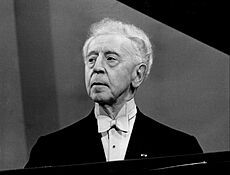



Many notable people were born or lived in Łódź, including:
- Grażyna Bacewicz (1909–1969), a famous composer.
- Jurek Becker (1937–1997), a writer.
- Marek Belka (born 1952), a politician and former Prime Minister of Poland.
- Karolina Bielawska (born 1999), who won Miss World 2021.
- Max Factor Sr. (1877–1938), who founded the famous cosmetics company.
- Marcin Gortat (born 1984), a basketball player who played in the NBA.
- Jan Karski (1914–2000), a diplomat and hero who tried to warn the world about the Holocaust.
- Daniel Libeskind (born 1946), a world-renowned architect.
- Roman Polanski (born 1933), a famous film director.
- Władysław Reymont (1867–1925), a writer who won the Nobel Prize.
- Joseph Rotblat (1908–2005), a physicist who won the Nobel Prize.
- Arthur Rubinstein (1887–1982), one of the greatest pianists of the 20th century.
- Andrzej Sapkowski (born 1948), the fantasy writer who created The Witcher series.
- Julian Tuwim (1894–1953), a beloved Polish poet.
- Jack Tramiel (1928–2012), who founded the computer company Commodore.
Łódź Around the World
Łódź has fourteen foreign consulates, which are offices that help citizens from other countries.
Sister Cities
Łódź has many "sister cities" around the world. These are cities that have special partnerships to promote cultural and economic ties.
 Chemnitz, Germany (since 1972)
Chemnitz, Germany (since 1972) Stuttgart, Germany (since 1988)
Stuttgart, Germany (since 1988) Lyon, France (since 1991)
Lyon, France (since 1991) Vilnius, Lithuania (since 1991)
Vilnius, Lithuania (since 1991) Odesa, Ukraine (since 1993)
Odesa, Ukraine (since 1993) Tianjin, China (since 1993)
Tianjin, China (since 1993) Tel Aviv, Israel (since 1994)
Tel Aviv, Israel (since 1994) Rustavi, Georgia (since 1995)
Rustavi, Georgia (since 1995) Barreiro, Portugal (since 1996)
Barreiro, Portugal (since 1996) Tampere, Finland (since 1996)
Tampere, Finland (since 1996) Puebla, Mexico (since 1996)
Puebla, Mexico (since 1996) Murcia, Spain (since 1999)
Murcia, Spain (since 1999) Lviv, Ukraine (since 2003)
Lviv, Ukraine (since 2003) Szeged, Hungary (since 2008)
Szeged, Hungary (since 2008) Guangzhou, China (since 2014)
Guangzhou, China (since 2014) Chengdu, China (since 2015)
Chengdu, China (since 2015)
Łódź is also part of the Eurocities network, which connects major European cities.
After the 2022 events in Ukraine, Łódź ended its partnerships with the Russian cities of Ivanovo and Kaliningrad, and with Minsk, the capital of Belarus.
Images for kids
See also
 In Spanish: Lodz para niños
In Spanish: Lodz para niños


